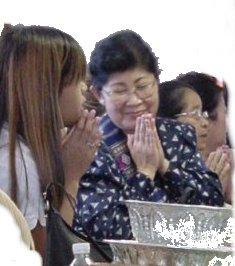
Nope is a way Lao people greet one another.
Nope is the joining of both hands with palms touching accompanied by a greeting or a salutation. The palms are not placed flat vertically. They are placed such that the palms form a cup resembling a flower bud, particularly the lotus. The joined hands can be anywhere between the chest and forehead. The level of the joined hands is determined by the person being greeted. If the person being greeted is from an older generation, the nope is raised to the forehead. If the person being greeted is of the same age range, then the nope is at the chest level. If you are greeting a person who is your senior, the nope is conducted with a slight bow. The bow is very slight, unlike the bending of the body seen in Chinese or Japanese tradition.
When a person nope, he usually will say sa by dee. Sa by dee means 'hello'. The nope is equivalent to the western handshake. In the U.S., nope is slowing being replaced by the hug.
Where did this practice from?
Like many traditions in Buddhism, the bowing and joining of hands definitely came from India. In modern day India, when two people greet, they say namaste (na mas tay). This tradition has been practiced thousands of years.
In Sanskrit, the root word namas means 'to bow, to submit, a reverential greeting' . Te means 'you'. From this, we derive that namaste means 'to bow to you'. In its deepest meaning, namaste is 'I honor or worship the Divinity within you.' A complete discussion of namaste is beyond the scope of this snippet. Namaste has greater meaning that just these few words of explanation.
In various parts of India, this act of greeting is called "namaskaram," "namaskara", or "namaskar".
| [Main Page] |
|
Copyright 2002 AZWATLAO.ORG, All Rights Reserved. Please do not use content without permission. |